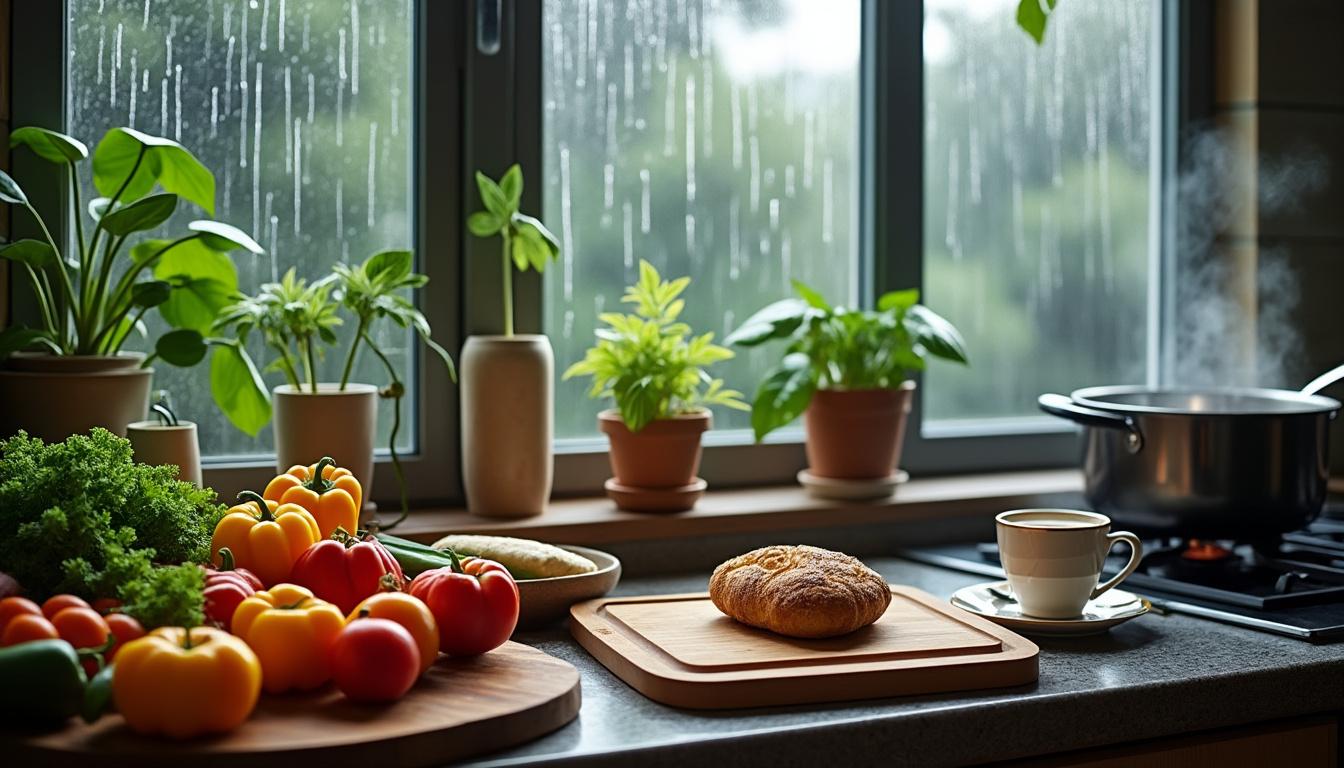The monsoon season transforms the culinary landscape with its unique challenges, requiring more than just ordinary kitchen practices. Humidity soars, ingredients become vulnerable to spoilage, and maintaining hygiene demands heightened vigilance. For home cooks and professionals alike, this season calls for strategic adjustments to guarantee a seamless cooking experience. From managing moisture levels to selecting the right cookware, mastering these essentials can prevent common setbacks such as soggy dishes or food contamination. By adopting optimized kitchen techniques and leveraging trusted equipment brands such as Tefal, KitchenAid, and Hamilton Beach, cooking during the rainy months can evolve from a hassle into an enjoyable ritual. This guide delves into practical tips designed to elevate kitchen efficiency and food safety, ensuring flavorful, consistent meals regardless of the weather outside.
Optimizing Kitchen Hygiene and Storage For Monsoon Cooking
Keeping the kitchen impeccably clean during the monsoon season is paramount due to the elevated risk of bacterial and fungal growth caused by high humidity. A meticulous approach to hygiene ensures food safety and helps extend the shelf life of ingredients. Moisture attracts pests and accelerates the deterioration of fresh produce, dairy, and spices, complicating daily meal preparation.
Employing airtight containers from reliable brands like OXO or Pampered Chef plays a vital role in preserving ingredient quality. These containers prevent moisture ingress, keeping spices and grains dry and aromatic. Vegetables and fruits should ideally be stored in perforated or ventilated containers to prevent condensation buildup.
- Regular disinfection routines: Using food-safe disinfectants on countertops, cutting boards, and handles reduces the chance of contamination.
- Proper ventilation: Ensuring adequate airflow in the kitchen diminishes dampness, discouraging mold growth on walls and cabinetry.
- Use of moisture absorbers: Silica gels or charcoal-based moisture absorbers can be placed near storage areas to control humidity.
- Temperature-controlled storage: Utilize appliances with humidity control features such as advanced refrigerators by Breville or Cuisinart for optimal preservation.
Careful inspection of ingredients before storage is essential; for example, washing vegetables with warm water mixed with vinegar can reduce microbial presence. Drying these thoroughly before placement enhances longevity. Frozen storage is advisable for excess perishables, leveraging products like Calphalon’s vacuum sealers to maintain freshness.
| Storage Item | Recommended Practice | Trusted Brand | Benefits |
|---|---|---|---|
| Spices & Grains | Use airtight containers, store in cool dry place | OXO, Pampered Chef | Maintains aroma, prevents clumping |
| Vegetables & Fruits | Wash, dry thoroughly; store in ventilated boxes | KitchenAid, Cuisinart | Reduces fungal growth, extends freshness |
| Perishables | Freeze excess quantities, use vacuum sealing | Calphalon, Breville | Retains nutrients and texture |
Incorporating these storage and hygiene tactics enhances the overall kitchen environment. For expanded culinary insights, exploring professional cooking tips from experts like Anne Burrell and Alton Brown can further refine monsoon cooking strategies (Anne Burrell Cooking Tips) and (Alton Brown Cooking Tips).
Selection Of Ideal Cookware And Appliances For Rainy Season Efficiency
The monsoon’s characteristic dampness requires cookware and appliances that are resistant to corrosion and moisture retention. Quality kitchen tools from brands such as Tefal, Lodge, Wilton, and Hamilton Beach facilitate cooking processes and ensure durability through the rainy months.
Non-stick pans with sturdy coatings, for instance, hasten cooking and make cleaning simpler — a vital consideration when dealing with wet weather-induced kitchen grime. Cast iron skillets by Lodge offer excellent heat retention necessary for slow-cooking monsoon staples and can withstand the moisture of this season when properly maintained.
- Prioritize non-corrosive materials: Stainless steel and anodized aluminum resist moisture damage better than ordinary metals.
- Choose multi-functional appliances: KitchenAid’s food processors and Hamilton Beach’s rice cookers can streamline meal prep to reduce kitchen time on humid days.
- Ensure tight-fitting lids: Prevent moisture from entering to keep flavors intact during cooking.
- Opt for appliances with easy clean features: Breville’s smart ovens and Calphalon’s nonstick cookware simplify sanitation routines.
An example involves using the KitchenAid mixer to blend batter efficiently, preventing lumps that can worsen in monsoon humidity. Meanwhile, the durability of Wilton bakeware ensures consistent bake-quality despite increased atmospheric moisture.
| Cookware/Appliance | Material | Recommended Brand | Monsoon Benefit |
|---|---|---|---|
| Non-stick Pan | Anodized Aluminum | Tefal | Quick cooking, easy cleaning |
| Cast Iron Skillet | Cast Iron | Lodge | Excellent heat retention, longevity |
| Food Processor | Stainless Steel & Plastic | KitchenAid | Reduces prep time, moisture-proof design |
| Oven | Stainless Steel | Breville | Efficient heating, easy maintenance |
Incorporating appliances and cookware with these qualities elevates the monsoon cooking experience, reducing stress and improving consistency. Those seeking deeper knowledge on kitchen tools can refer to culinary advice on cooking techniques and kitchen appliance usage (cooking tips culinary skills).
Adapting Cooking Techniques To Combat Humidity Challenges
Higher humidity in the monsoon season affects cooking methods, especially dehydration and roasting. Understanding the impact of moisture on food during cooking is critical to avoid soggy textures or diminished flavors. This calls for nuanced adjustments in heat levels, cooking duration, and preparation methods.
Foods tend to absorb moisture from the air, so utilizing techniques that reduce moisture exposure is essential. For instance, shallow frying instead of deep frying can prevent dishes from becoming overly oily or soggy. Similarly, roasting items like nuts or spices in a dry skillet can revive their aroma and crunch, which is often lost in humid conditions.
- Increase cooking temperatures moderately: Faster cooking reduces prolonged exposure to moisture.
- Use fresh ingredients: Avoid pre-washed packaged ingredients that carry excess moisture.
- Apply covering techniques: Use lids or foil wraps to seal in moisture without making dishes soggy.
- Incorporate slight toasting: Toasting grains or flours before use enhances flavor and shelf life.
Cuisinart’s multi-cooker with precise temperature controls exemplifies modern gadgetry that supports these technique adaptations, allowing users to manage heat and time for optimal results even in challenging weather. Additionally, incorporating Lodge’s seasoned cast iron products for roasting spices or slow-cooking enhances both flavor and texture.
| Technique | Recommended Adjustments | Ideal Appliance/Tool | Effect on Monsoon Cooking |
|---|---|---|---|
| Shallow Frying | Use less oil, cook quickly | Tefal Non-stick Pan | Prevents soggy texture |
| Roasting Spices | Dry roast in skillet before use | Lodge Cast Iron Skillet | Enhances aroma and crunch |
| Toasting Grains | Lightly toast grains or flour | Calphalon Non-stick Pan | Improves shelf life and flavor |
For step-by-step tutorials on adjusting culinary techniques during monsoon, viewers may find practical insights from Julia Child’s cooking tips beneficial (Julia Child Cooking Tips).
Efficient Meal Preparation And Time Management Amidst Monsoon Constraints
Time management in the kitchen assumes added importance during monsoon due to frequent power fluctuations, increased humidity, and potential ingredient spoilage. Streamlining meal prep ensures minimal wastage and consistent dish quality.
Batch cooking is a valuable strategy, enabling the preparation of larger quantities to be stored and consumed over several days. Utilizing programmable appliances like Hamilton Beach slow cookers and Breville steam ovens can automate multiple tasks, freeing up time for other activities.
- Plan meals based on ingredient longevity: Prioritize recipes using non-perishable or long-lasting items.
- Prepare mise en place: Organize all ingredients beforehand to reduce active cooking time.
- Use timers and programmable appliances: Prevent overcooking and save electricity amid unstable power supply.
- Maintain a clean workspace: Cleaning as you go reduces clutter and post-cooking effort.
An illustrative case involves using Hamilton Beach rice cookers’ delay start function to have freshly cooked rice ready when desired, even with unpredictable power availability. Similarly, Breville’s multi-functional steam ovens expedite vegetable cooking, preserving nutrients and texture despite moist surroundings.
| Time Management Strategy | Tools/Appliances Recommended | Benefit |
|---|---|---|
| Batch Cooking | Hamilton Beach Slow Cooker | Reduces daily cooking time |
| Meal Planning | KitchenAid Food Processor | Streamlines ingredient prep |
| Use of Timers | Breville Multi-Functional Oven | Prevents overcooking, energy efficient |
Mastering these strategies can significantly improve kitchen workflow during the monsoon. For added professional culinary guidance, consulting comprehensive resources such as Alton Brown’s holiday cooking tips proves advantageous (Alton Brown Holiday Cooking Tips).
Incorporating Monsoon-Specific Ingredients And Flavor Enhancements
The monsoon season not only challenges the culinary process but also presents a chance to embrace seasonally resonant ingredients that complement the damp climate. Incorporating these ingredients creates meals that both nourish and delight, fitting the weather and elevating taste.
Root vegetables like taro and sweet potatoes, as well as seasonal greens such as spinach, thrive during this season and withstand humidity when properly stored. Additionally, herbs such as coriander and mint add freshness and aid digestion, commonly desired during the rainy months.
- Utilize warming spices: Cinnamon, clove, and ginger introduce heat and help combat monsoon chill.
- Incorporate fermented foods: Items like pickles and chutneys, often prepared using Calphalon or Wilton’s durable containers, preserve flavors and provide probiotic benefits.
- Favor quick-cooking grains: Millet and semolina are ideal, maintaining integrity despite moisture.
- Balance flavors carefully: Combine sour, salty, and sweet elements to counteract the season’s damp heaviness.
Cuisinart’s precision food processor assists in creating smooth chutneys and spice blends, while Pampered Chef’s versatile bakeware is suited for preparing fragrant monsoon-friendly breads and snacks. This synergy of tools and ingredients shapes a vibrant, seasonally appropriate culinary experience.
| Ingredient | Seasonality | Common Uses | Health/Flavor Benefit |
|---|---|---|---|
| Sweet Potatoes | Monsoon | Roasted, mashed, stews | Rich in fiber, warming |
| Coriander & Mint | Monsoon | Garnishes, chutneys | Freshness, digestion aid |
| Cinnamon, Clove, Ginger | Year-round, enhanced in monsoon | Spices for teas, curries | Warming, antimicrobial |
| Millet and Semolina | Monsoon | Breakfasts, porridges | Quick cooking, moisture-resistant |
For recipes that optimally use these monsoon ingredients, consult expert culinary resources like those found in Thanksgiving cooking tips, which often incorporate seasonal adaptations (Thanksgiving Cooking Tips).
FAQ: Essential Kitchen Tips for a Hassle-Free Cooking Experience During the Monsoon Season
- Q: How can I prevent my spices from clumping during the humid monsoon months?
A: Storing spices in airtight containers by brands like OXO or Pampered Chef in a cool, dry cupboard is essential. Adding moisture absorbers such as silica packets can dramatically reduce clumping. - Q: Which cookware materials are best suited for monsoon cooking?
A: Opt for non-corrosive materials such as anodized aluminum and cast iron. Brands like Tefal and Lodge provide excellent options that withstand humidity while providing consistent cooking performance. - Q: What cooking techniques help maintain food texture despite high humidity?
A: Techniques such as shallow frying, dry roasting spices, and toasting grains minimize moisture absorption and preserve crispness and freshness. - Q: How can I manage kitchen time effectively during unreliable power supply common in monsoons?
A: Utilizing programmable appliances like Hamilton Beach slow cookers and Breville ovens with timers can automate cooking and prevent spoilage, optimizing kitchen time despite power issues. - Q: Are there specific ingredients that enhance monsoon dishes?
A: Yes, seasonal ingredients like sweet potatoes, coriander, mint, cinnamon, and ginger not only complement the monsoon palate but also aid digestion and add warming qualities.

